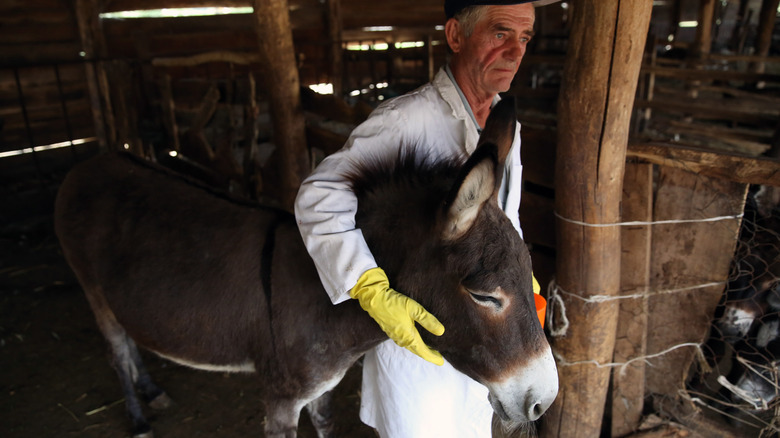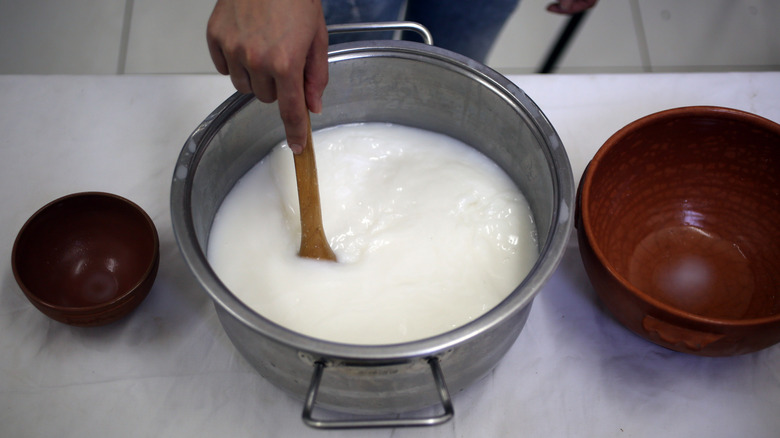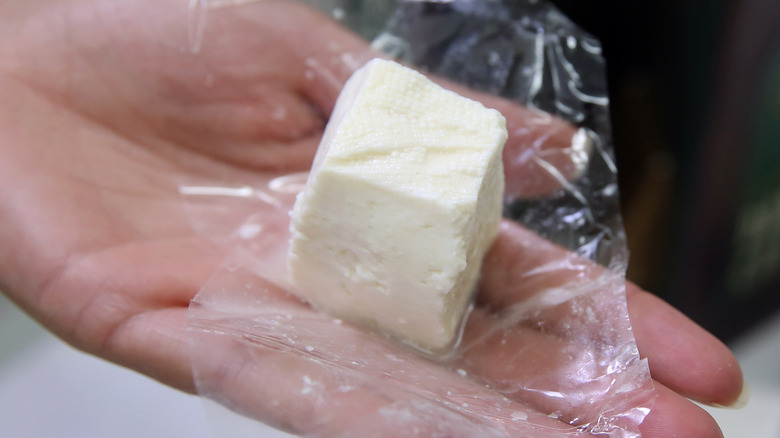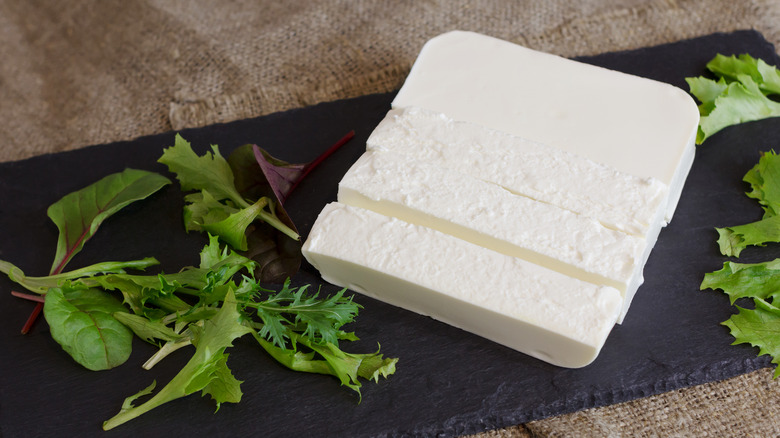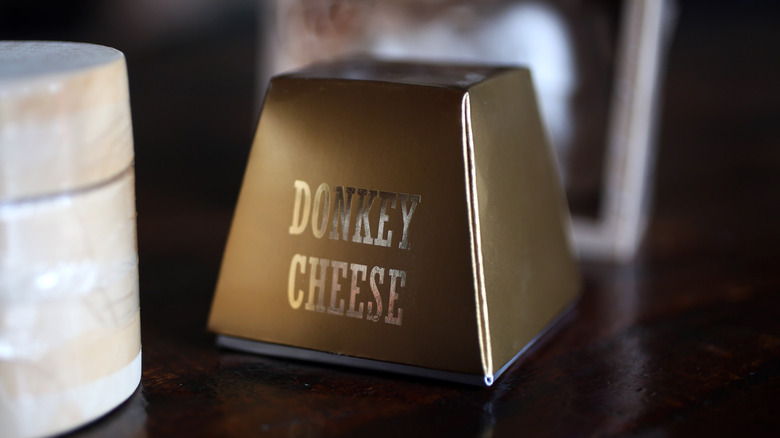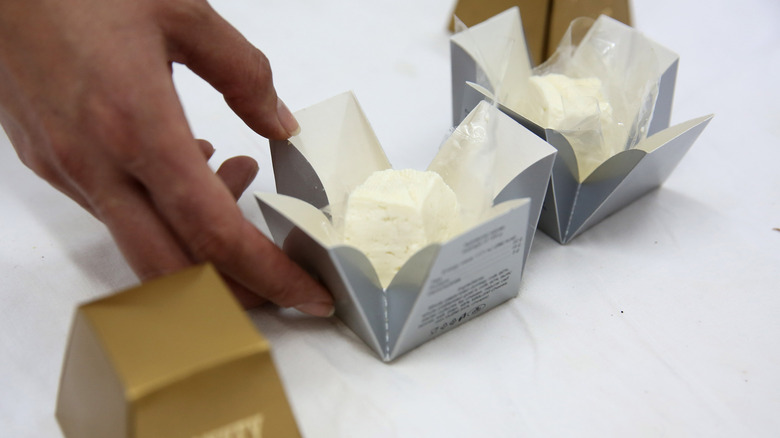The Expensive Serbian Cheese That's Made With Donkey Milk
Cheese aficionados are undoubtedly familiar with cheeses made from cow's milk as well as sheep and goat milk cheeses. But one elusive cheese that might surprise most is made from donkey milk. Serbian Pule donkey cheese, also known as magareći sir or more simply "pule," is a unique and highly sought-after cheese made from the milk of the Balkan donkey (via BBC Travel). Balkan donkeys are a rare breed of donkey that is native to Serbia and the surrounding region. Made using traditional methods, this exclusive cheese is known for its distinct, strong flavor and high quality.
Pule cheese is considered a delicacy and is highly prized by gourmet food enthusiasts. It is often used in high-end restaurants and is a popular choice among cheesemongers and gourmet food shops. The cheese is also used in traditional Serbian cuisine and is a popular ingredient in many dishes.
But because of the small number of donkeys that are available for milking, pule cheese is quite difficult to come by and therefore expensive. That's why it is considered a luxury food item and is not easily obtained. However, for those who can find and taste it, Pule donkey cheese is truly a unique and unforgettable culinary experience.
What is pule donkey cheese?
Pule cheese is made from 60% donkey milk, which is known for its high nutritional value according to Neo Science Hub, and 40% goat milk (via Business Insider). Pule has a signature, complex flavor, with a nutty and slightly sweet taste. Balkan donkeys only produce up to one gallon of milk per day for six months and carry their babies for 54 weeks. That means the little milk they do produce is scarce given the long gestation period each female donkey must endure. Additionally, breeding and milking donkeys has become a rare activity, making the cheese even rarer and more expensive.
The cheese is made using traditional techniques that have been passed down for centuries. Like most cheeses, the milk is first curdled with the use of rennet, and then the curds are drained and pressed into molds (via BBC Travel). The cheese is aged for around a month making it a young, rindless cheese according to The Cheese Atlas.
How is it made?
The process of making pule starts with collecting milk from the donkeys — by hand, up to three times per day according to The Cheese Atlas. It's then processed into cheese using secret, traditional techniques (via Business Insider). But there are a few key steps that the one-and-only pule maker, Slobodan Simić, has shared.
The first step in the cheese-making process is to curdle the milk using rennet according to BBC Travel. Rennet is a natural enzyme that is used to separate the curds and whey from the milk (via The Spruce Eats). Once the milk has curdled, the curds are drained and pressed into molds. The molds are then placed in a cool, humid room for roughly three days to allow the cheese to begin to form (via The Cheese Atlas).
After the cheese has been pressed and shaped, it is then aged for a month. Once the aging process is complete, the cheese is ready to be packaged and sold for top-shelf prices. According to The Cheese Atlas, pule cheese costs, on average, $600 per pound.
This sets the Serbian cheese apart
If you're wondering just why this special type of cheese can fetch such high prices, you're not alone. First and foremost, the donkey milk used to make pule cheese is not commonly found and is a very laborious, time-consuming milk to produce and collect. The milk is so uncommon that there is only one farm in the world that produces pule cheese, and it is located in Serbia (via Business Insider).
Another reason why pule cheese is different is its unique and strong flavor. This unusual cheese has a soft yet crumbly texture according to Culture Cheese. It is also described as having a flourishing flavor that resembles manchego. However, if you're lucky enough to taste pule, you will find it has far more flavor.
Pule cheese is also highly sought after for its nutritional value. According to Neo Science Hub, donkey's milk contains high levels of minerals, vitamins, and proteins, which makes it a healthy option. Additionally, the cheese is low in fat and cholesterol, making it a great choice for those watching their diet.
What does it taste like?
Pule cheese is known for its strong, pungent flavor and unique texture. The flavor is often described as that of young manchego which is nutty and earthy, with a hint of saltiness (via Cheese and Such). It has a tangy, slightly sour taste that is balanced by the rich, buttery flavor of the donkey's milk. It is often described as having a mild, clean flavor according to BBC Travel. But the texture of pule cheese is quite different. Instead of being a hard cheese, it is soft, crumbly, and dry according to Culture Cheese. Think of it as being similar to feta or ricotta that has been strained for a longer period of time.
Overall, pule cheese is a delicacy that is not for the faint of heart thanks to its sky-high price tag. But its subtle, mild flavor and unique texture may be worth it for the most avid of cheese lovers who appreciate complex flavors. It is clearly a beloved delicacy that shouldn't be missed.
How to use the donkey cheese
Pule is a delicacy that is typically served in small portions (via Culture Cheese). Due to its high cost, it is often considered a luxury item and is served in fine dining restaurants or used in traditional Serbian recipes according to BBC Travel.
But pule cheese is also used as a garnish or a topping on various traditional dishes, such as polenta or goulash, in the Balkan region. Another way to enjoy pule cheese is to use it in cooking. It can be mixed into a risotto or polenta dish to add depth and complexity to the dish.
When it comes to serving pule cheese, it is best to keep it simple according to The Cheese Atlas. If you want to spruce up the already striking yet mild cheese, place a small piece of the cheese on a plate with a drizzle of olive oil and a sprinkle of coarse sea salt to bring out the flavors of the cheese. It can also be served alongside charcuterie (via BBC Travel).
While there are many ways to enjoy this rare and unique cheese, its flavor and texture make it a versatile ingredient that can be used in a variety of dishes. Regardless of how it is served, it is sure to impress your guests and dining companions.
Where to buy pule donkey cheese
Pule cheese, also known as donkey cheese, is considered one of the rarest and most expensive cheeses in the world. Due to its limited production, it can be difficult to find and purchase.
One way to purchase Pule cheese is through online retailers that specialize in gourmet and specialty foods (via Zasavica). They may carry a small selection of Pule cheese and ship it to customers worldwide. But remember that it is important to check the authenticity and the quality of the cheese before purchasing it from an online retailer.
Another option is to visit specialty food stores that carry a variety of rare and exotic cheeses. These stores may carry pule cheese, but it is not a common find and the availability may vary. If pule cheese is found in these high-end gourmet and specialty food stores, it is more likely to be in limited stock and might be more expensive than purchasing it online.
The best option for buying pule cheese is a trip to the Balkan country itself (via BBC Travel). Pule can be bought from the farm that produces it in Serbia. As rare and expensive as pule is, it shouldn't be surprising that it may take some effort to find and purchase it.
Nutritional information for the cheese
One of the main nutritional benefits of Pule cheese is that it is a good source of protein according to Neo Science Hub. Protein is essential for maintaining and building muscle, and it also helps to keep you feeling full and satisfied. Pule cheese is also high in minerals such as calcium which are essential for maintaining strong bones and teeth.
Pule is also a good source of vitamins — particularly vitamins A, B, and E. Vitamin A is important for maintaining healthy eyes and skin, while vitamin B12 is essential for maintaining a healthy nervous system. It is even as more than 60 times the amount of vitamin C found in regular cow's milk cheese according to the Independent.
With just 1% fat and anti-allergen properties, it's easy to understand why pule is considered a health-food by many too.
Pule cheese is truly one of a kind. From its unique origin of milk, traditional production methods, unusual flavor, and nutritional value, it's no wonder why this cheese is considered a delicacy. If you ever have the opportunity to try pule cheese, don't pass it by!

